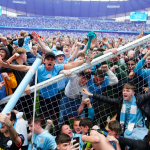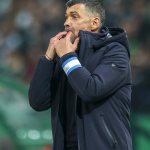
The pitch invasions are back
After two years of closed stadiums, fans have returned to reclaim their spaces but there has been no shortage of unpleasant incidents
June 3rd, 2022
In chronological order, the latest case happened immediately after the decisive penalty in the challenge to remain in Ligue 1 between Auxerre and Saint-Étienne, with the latter's fans climbing over the reviews and past the stewards entering the field with smoke bombs and iron rods. Anger over relegation after 18 years quickly erupted into acts of violence, with players being forced to take cover in the locker room under dense throwing of flares and various objects. It was a terrible scene that unfortunately has been increasingly common in recent months, with numerous cases of pitch invasions in major European leagues from England to France to even Italy.
Envahissement du terrain au stade Geoffroy-Guichard. #ASSE #ASSEAJA pic.twitter.com/N7pX2NVrhj
— Adrien Blettery (@AdBlettery) May 29, 2022
Already in the summer there were the first indications, especially in France, during Olympique Marseille's matches against Nice and Angers, not only because of intemperance by OM fans but from a general tension in the stadiums of the transalpine league. And that in May, with the stadiums finally at full capacity and the arrival of the season's most important matches, exploded as we saw on the evening in Saint-Étienne, where the most violent bangs of the organized supporters turned the end of the match into a manhunt.
But even in England there have been several instances of pitch invasions, often less dramatic than those in France, but which in some cases have degenerated beyond the celebration of victory. During the pitch invasion of Nottingham Forest fans after their team's historic promotion they tried to hit Sheffield United captain Billy Sharp, while in the celebrations at Etihad Stadium for Manchester City's title, Aston Villa goalkeeper Robin Olsen was hit in the back of the head by an unidentified invader.
The next day, following Everton's nail-biting victory that earned the Liverpool team salvation, Crystal Palace coach Patrick Vieira was involved in an argument with opposing team supporters who had entered the playing field. In the League Two playoff semifinal between Port Vale and Swindon Town, the latter's players were attacked on the field with kicks and punches. It is a situation that is alarming in no small measure the English federation, which historically has been very cautious about matters involving cheering, organized or otherwise, and which evokes sad memories.
In Italy, too, even without reaching foreign cases, we have seen non-exemplary pitch invasions, such as during the Serie C match between Foggia and Catanzaro, when a fan attempted to hit Iemmello before the execution of a penalty kick. Or the match between Napoli and Spezia suspended for 12 minutes because of the escalation between the two corners to an attempt to climb over the protective barriers, and finally the latest invasion by Milan fans on the final of the Scudetto match in Reggio Emilia with the medal ripped from Stefano Pioli's neck.
Not all pitch invasions, however, are to be stigmatized. In many cases they have signified a return to normalcy and the affection that binds fans to their team, physically expressed through running toward their players without waiting for the referee's whistle first. As was the case at Millwall, whose supporters habitually ran onto the pitch after the last game of the season with stewards doing nothing to prevent it, or the Giallorossi's who invaded an empty Stadio Olimpico during the Conference League final being played in Tirana.
The scenes with fans filling the soccer field with the colors of their scarves and flags reappropriate the sport with its more physical, material, experiential dimension of which the stadium, with all its rituals, uniqueness and contradictions is the perfect synthesis. The important thing is that such demonstrations of passion and enthusiasm are limited to that and do not become a way to dump two years of closures on players and clubs.





















